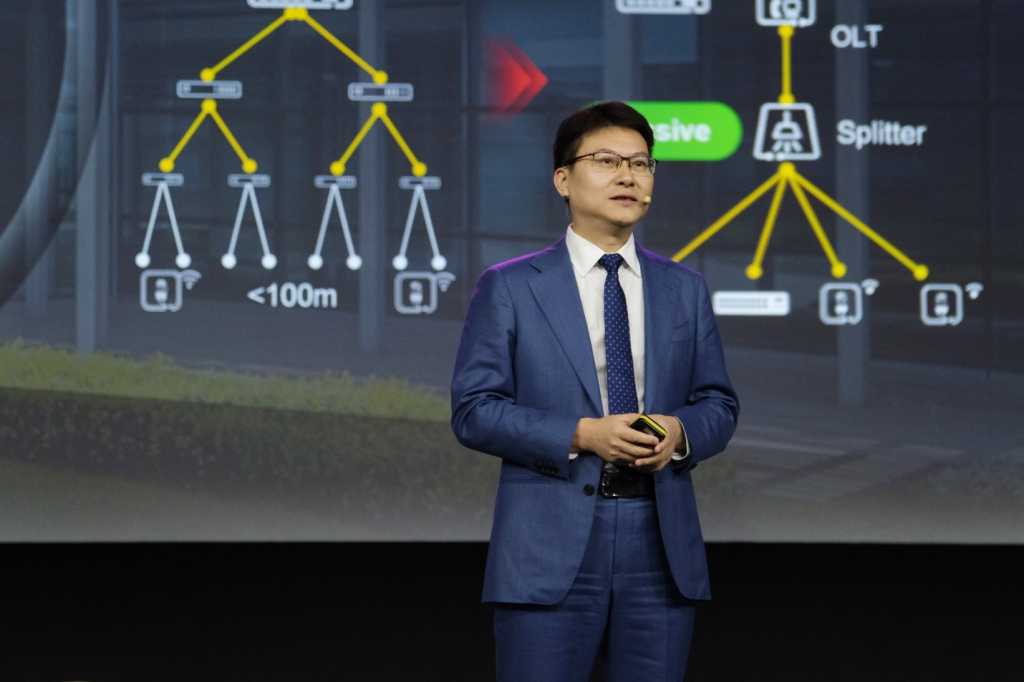As a pioneer of innovative F5G/F5G Advanced (F5G-A) solutions, Huawei has continually explored the potential of fiber to build faster, multi-dimensional sensing and more sustainable networks that can meet the demands of industrial developments. We examine three trends that Bob Chen, President of Huawei Optical Business Product Line, shared at Global Optical Summit 2024, to find out what is in and what is out, and how that may shape today’s optical networks.
Trend 1: Fiber-in, Copper-out
As carbon neutrality goals are formulated worldwide, optical fibers are becoming increasingly favored over copper for their durability, functionality, and energy efficiency.
“Fiber-in copper-out is not a new topic,” said Mr. Chen. “Over a decade ago, operators started replacing copper networks with optical networks, and the number of global FTTH users now exceeds 900 million. Fiber-in copper-out is also moving to campuses”.
In the 10 Gbps campus era, Wi-Fi 7 is indispensable as it supports high-bandwidth wireless access from 3 to 18 Gbps. But this means existing copper cables in most campuses must be replaced with optical fiber due to copper’s inability to support such high speeds. Optical fiber has a 30-year service lifespan and supports 100 Tbps bandwidth and unlimited distance on campuses. All this makes optical fiber the best choice for building campus networks.
 Bob Chen, President of Huawei Optical Business Product Line
Bob Chen, President of Huawei Optical Business Product Line
Huawei
Compared with traditional technologies, the fiber-to-the-office (FTTO) solution only requires devices in the CO equipment room and terminals and uses passive optical splitters to replace active devices. According to Chen, this reduces cabling costs by 80%, lowers O&M workload by 50%, and decreases power consumption by 30%. In addition, fiber deployment is a one-time operation with a lifespan of 30 years.
The in-depth development of digital education has caused new services to emerge, and campus networks are now faced with challenges in bandwidth, network construction costs, and network evolution. Other industries such as healthcare and manufacturing also demand higher network capacities to facilitate AI applications and IoT devices. And with Wi-Fi 7 promising even higher throughput and lower latency, having the right underlying network infrastructure is becoming more critical than ever.
Used by over 8,000 enterprise customers across education, healthcare, and hospitality, Huawei FTTO has received the Outstanding POL Use Case Award at Broadband World Forum 2023. The award-winning Huawei FTTO Solution upgraded to the next generation FTTO 2.0 Solution, aiming to fulfil smart on-site application demand by delivering bandwidths of 12.5G/25G to the room, 2.5G/10G to the AP, and 2.5G to the desktop. The upgraded network also features hard-slicing technology that enables multi-service bearing over singular networks without interference. Additionally, the NCE platform unifies IP and POL network management to reduce operational costs of green 10G all-optical smart campus networks by up to 30%.
“Huawei is committed to providing the most advanced and green optical campus network solutions and products for global enterprise customers,” said Gavin Gu, President of Huawei’s Enterprise Optical Network Domain. “We will continue to work with customers and partners to promote the commercial deployment of green 10G optical campus networks with more innovative technologies.”
Trend 2: fgOTN-in SDH-out
For decades, Synchronous Digital Hierarchy (SDH) has been vital for securely transporting large amounts of data over long distances. But it can no longer keep up with video-based intelligent development in the industry. Digital substations, for example, generate nearly 20 times more traffic. In response to the exponential increase in capacity demand, the International Telecommunication Union-Telecommunication Standardization Sector (ITU-T) announced their approval of the fine-grain OTN (fgOTN) standard to replace SDH in December 2023. Shortly after, Huawei released the first-ever fgOTN-compliant optical transmission product at MWC Barcelona 2024.
“In addition to SDH, fgOTN is the only technology standardized internationally that supports constant bit rate (CBR) services in the industry, as well as efficiently supporting Ethernet services with agile hitless bandwidth adjustment,” explained Dr. Xiang Liu, a senior expert in international optical communications standards. “The release of the fgOTN standard signifies the transition of communication networks from the SDH era to the fgOTN era.”

TDM-based hard pipes in fgOTN-compliant products offer zero interference and jitter by completely isolating services, critical for meeting small-granularity CBR service requirements in teleprotection and railway train control. In addition, bandwidths have increased tenfold to 100G per wavelength, with future upgrades expected to reach 80 times the pre-fgOTN capacity at 800G. At the same time, fgOTN-compliant products remain compatible with PCM/PDH/SDH/ETH/SDI services, preserving familiar O&M practices while facilitating a seamless upgrade transition.
Trend 3: Optical-Sensing-in Hard-Work-out
Many industry scenarios, such as oil and gas pipeline and perimeter inspection, still require manual onsite operations. In addition to repetitive outdoor work, these operations can expose employees to health and safety issues in bad weather conditions.
When combined with intelligent analysis, optical fiber sensing can automate perimeter inspection and pipeline monitoring to allow employees to work from a comfortable office. Streamlining perimeter inspections has also minimized on-the-ground inspection errors, leading to increased productivity in railways, airports, and large campuses.
With more than 30 years of experience in optical technologies, Huawei has developed an innovative pipeline fiber sensing solution using distributed fiber optic sensing technology. In the solution, Huawei optical sensing device and the sensing algorithm engine (SAE) are deployed to implement 24/7 high-precision automatic pipeline inspection and warning.
Huawei has developed a multi-dimensional sensing convergence solution for video and optical fiber sensing. In perimeter inspection scenarios, Huawei’s optical-visual linkage perimeter inspection solution integrates optical fiber and video sensing for optimal judgment, achieving zero false negatives.
To learn more about Huawei optical products and solutions, click here.
>>> Read full article>>>
Copyright for syndicated content belongs to the linked Source : CIO – https://www.cio.com/article/2515747/three-trends-showing-how-all-optical-networks-drive-digital-intelligence.html










